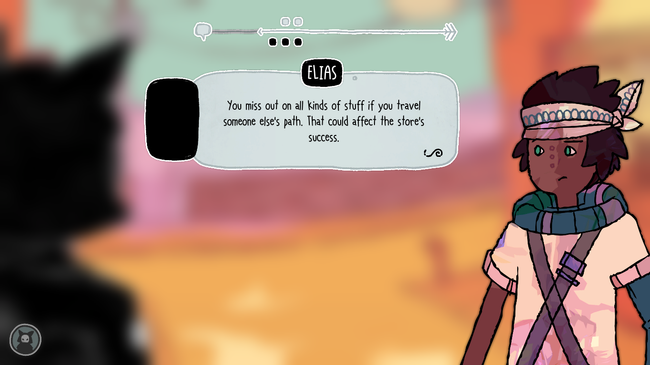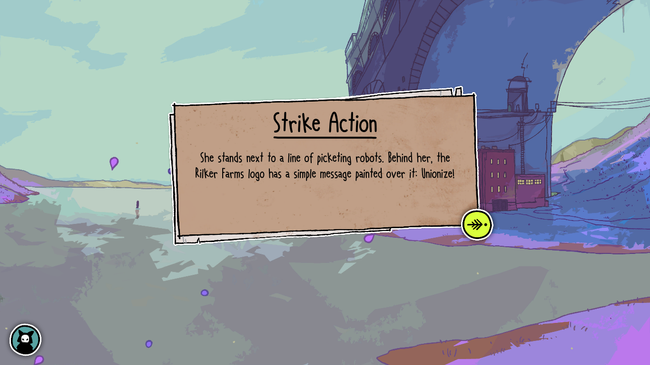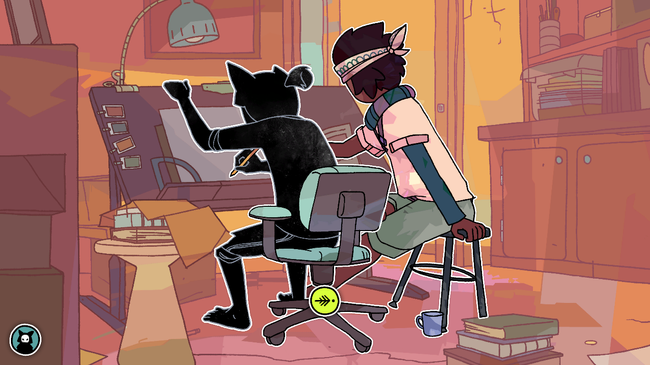Signs of the Sojourner Review
We’re currently in a very difficult and unexpected time. While the world is self-isolating and quarantining, it’s easy to turn to video games to provide some kind of support. In Signs of the Sojourner, you are put into the life of someone actively seeking such support. The playable character has recently lost their mother, and they are tasked with taking over her place in a traveling caravan. Not only is this a way to continue her legacy and keep her store open, but it also becomes clear that the next five caravan trips you go on will determine if your hometown will fall into obscurity due to financial instability or make its way back to being the prosperous town your mother worked for during her lifetime. It’s a daunting task solely built around being able to communicate with the people you meet using the cards you collect along the way.
At its core, Signs of the Sojourner is a deck-building card game with elements of a visual novel. It’s the implementation of cards in Signs of the Sojourner that instantly drew me to the game and sets it apart from the usual card game system, where the goal is to use skill cards to defeat or outwit an opponent. With Signs of the Sojourner, I wasn’t building a deck of specific skills or party buffs. I had to build a deck with a full range of emotional maturity.

While traveling with the caravan searching for items to stock your mother's shop with, it’s possible to talk to every person in each town as they are the ones with goods and directions to new locations. Locals from the town will often have a similar conversation style to one another, but ultimately each person will have different cards that represent how they communicate, and the goal is to match symbols with them to continue the chain and flow of conversation. Like everyday life, some people can handle more misunderstandings (mismatched cards) in their conversations than others, but ultimately the conversation will be successful as long as it ends in a common, understanding place.
This card system is the only way to communicate in Signs of the Sojourner and it’s broken down into symbols. There isn’t a dialogue tree and picking the right sentence to boost relationship points is never an issue. There’s a deck of 10 cards with each symbol representing emotions or rhetoric such as “logical” or “empathetic”. Some cards come with special traits attached to them like “accommodate” that allow you to work around misunderstandings and better prepare your deck for the next step you’ll take in the conversation. These cards become the dialogue. Despite conversations being fully one-sided, characters react to the cards played in a way that’s so diverse and distinct to each individual. In a way, the lack of dialogue actually becomes liberating at a certain point in the game. There’s space that allowed me to use my imagination and fill in the blanks with all the possible responses that could have led up to a character's reaction.

With symbol matching being the only way to communicate, the options available do seem limited at first. Rather than creating this vast repertoire of cards, I started with multiples of the same one. Communicating with that lifelong friend is easy in those opening moments, compared to meeting a stranger that lives three towns over. Going through the world and meeting people with different conversational styles was an equal mix of difficult and rewarding. It’s frustrating at first to constantly leave conversations empty-handed and disappointed. No one likes trying to communicate with someone and constantly hitting roadblocks. I often found myself at a loss when trying to make a deck that would suit everyone I would meet. If you’re fine with playing and realizing that pleasing everyone and having a perfect first run most likely isn’t possible, this mechanic feels refreshing. If not, it’ll be a hard hurdle to get over.

I do appreciate that there isn’t a real fail state in Signs of the Sojourner though. If a conversation “fails”, the person I wasn’t able to connect with isn’t blocked when I revisited their town simply because we didn’t get along the first time we met. I wasn't immediately locked out of content because my communication style clashed with someone else's. Despite a conversation ending in vague or somewhat hostile terms, a part of each character still comes with you in the form of a card that carries the symbols of their conversation style. While the game doesn’t force you to talk to each and every person and you’re able to leave a town whenever, there are clear benefits to meeting each person you see. There’s room to grow and learn from each character, to learn more about the world you’re moving through and figure out the person you’re going to be, if you’re willing.
The narrative in Signs of the Sojourner is steeped in that sense of growth and change. Figuring out the way it interacts with gameplay is incredibly captivating. There was a point in the game where I had assumed I had every type of card in my deck or at the very least had seen each type. It wasn’t until I traveled to a city that had recently been affected by an earthquake that I realized a grief card existed. A simple mechanic, such as talking to a person and introducing a grief card to the deck became a narrative point that allowed me to be a part of the world-building. I was able to learn more about and experience the lasting effects climate change had on the world and its people.

Whether extreme climate changes left a town in a constant drought or surrounded by water, these new realities work their way into the narrative through natural disasters, industrialization, and new means of transportation or even discussion of refugees and unionizing. Never did these conversations feel like a heavy-handed critique of society or a voyeuristic look at people struggling. It was more like an examination of the world we’re living in and how circumstances will change the course of life, which in turn changes the course of your journey. NPCs aren’t simply there to hand over items once I beat them in a match. Each one of them has a backstory, relationships with other people, and things they chose to prioritize.

Signs of the Sojourner takes the typical deck-building formula and makes it less about strategizing and more about connecting with people the way you want to. The characters you can meet seem endless and the world-building is ridiculously robust for a game that looks simple on paper. Nothing prevents you from reshaping your character as you travel and find your place as the head of your family business. Relationships change as you go and the deck you start with isn't the deck you end with. It manages to turn the simplest of game mechanics, such as a rest stop, into small moments that give you a chance to breathe and see what life is like when you just slow down.
Signs of the Sojourner feels like life. It gets hard when you least expect it, sometimes returning home is a blessing and other times it feels like a burden. People change, life moves on and you just have to try to keep up. It takes something as impersonal as cards and creates an entire world full of personality.